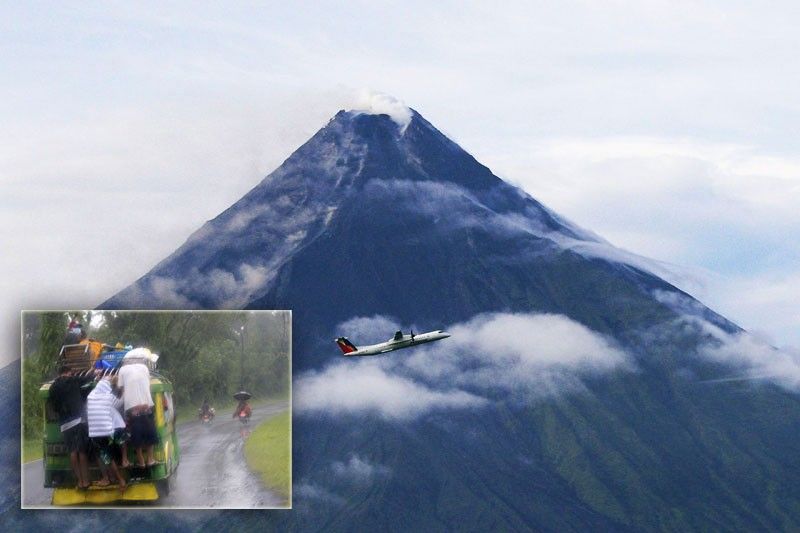Phivolcs warns of Mayon’s hazardous eruption

A Philippine Airlines plane flies near Mayon Volcano in Legazpi, Albay yesterday. Inset shows residents from Barangay Amtic in Ligao town being evacuated amid heavy rain as Mayon remains under Alert Level 3.
MANILA, Philippines — Alert Level 3 has remained up over Mayon Volcano yesterday as state volcanologists continued to warn of a possible hazardous eruption “within weeks or days.”
Science and Technology Undersecretary and Philippine Institute of Volcanology and Seismology (Phivolcs) director Renato Solidum yesterday said Mayon’s activity could last for months.
However, volcanologists have yet to see manifestations of a destructive explosion of Mayon similar to its eruption in 1814, which killed 1,200 people.
Solidum likened Mayon’s current activity to its eruption in 2000 where it started with a lava flow episode that transformed into a more explosive phase.
“We don’t see the worst case scenario in the current activity. We are looking at a moderate-sized activity,” Solidum said during the launch of the Philippine Earthquake Model Atlas at the Phivolcs head office in Quezon City yesterday.
Mayon’s most destructive eruption was in February 1814 when the volcano demonstrated a Plinian blast – the largest and most violent type of eruption, killing roughly 1,200 people.
The second deadliest eruption was in 1897, which killed 350 people “most likely due to pyroclastic flows.”
“Sometimes this would last for several months,” he said, noting that the fastest eruption was in 2009 when the eruption and evacuation lasted for just two weeks.
Mayon started acting up last weekend when it had three phreatic explosions in less than 24 hours, spreading ash in many areas in Albay.
The Albay government has placed the province under a state of calamity.
Ash fall spewed by Mayon since its explosion last Jan. 13 and heavy rains spawned by the tail-end of the cold front are complicating disaster response after two cases of diarrhea were reported in Guinobatan, Albay due to contaminated water wells.
“We are now facing multiple risks from Mayon and the (tail-end of cold front),” said Cedric Daep, head of the Albay provincial security and emergency management office (APSEMO), yesterday.
APSEMO is verifying reports of the two children in Guinobatan who are suffering from diarrhea after they drank contaminated water.
Daep also warned villagers staying at evacuation centers not to go back to their houses or tend their animals due to the risk of pyroclastic flows, which are now more difficult to observe due to heavy cloud formation at the vicinity of the volcano.
Office of Civil Defense (OCD) regional director Claudio Yucot said classes have been suspended in Camarines Sur, Camarines Norte and Catanduanes due to the cold front’s tail-end.
OCD said 7,779 families or 33,250 persons are now staying at various evacuation centers.
Legazpi Mayor Noel Rosal said classes at all levels in the city are suspended, even those outside the five barangays located in the extended one- kilometer danger zone or eight kilometers from the volcano.
Rosal said 2,462 families or 11,500 persons from the five barangays are staying at Bagumbayan Elementary School, Albay Central School, Gogon Central School and Gogon High School and Bogtong Elementary School.
“But we are going to decongest the 10 families per classroom to seven to ensure sanitation, cleanliness and prevent the outbreak of communicable ailments,” said Rosal.
“Pyroclastic materials and ash fall could be mobilized by heavy rainfall in river channels around the volcano that could trigger a lahar flow,” said Ed Laguerta, Mayon resident volcanologist based at Ligñon Hill Observatory.
Lava collapse events corresponded to rockfall along the front and margins of advancing lava and pyroclastic flows down the river channels of Miisi, Matanag and Buyuan Gullies within the permanent danger zone (PDZ).
Sulfur dioxide gas emission was measured at an average of 3,293 tons a day last Tuesday.
A mild tremor was felt in Ligao City and in Oas, Albay early yesterday morning.
Phivolcs said a tectonic quake with magnitude 2.0 was felt in Ligao at 12:01 a.m. while a 3.1 magnitude quake followed at 12:37 a.m. with a depth of 18 kilometers in Oas, which was felt at Intensity 3 in Legazpi City and Intensity 1 in Iriga City, Camarines Sur.
Laguerta said the earthquakes were not related to the eruption.
After hundreds of families were found residing inside Mayon’s PDZ despite their relocation years ago, disaster control officials are renewing their appeal for Congress to pass a law prohibiting people from living within a radius of at least six kilometers of the volcano. – Celso Amo, Cet Dematera
Related video:
- Latest
- Trending



























